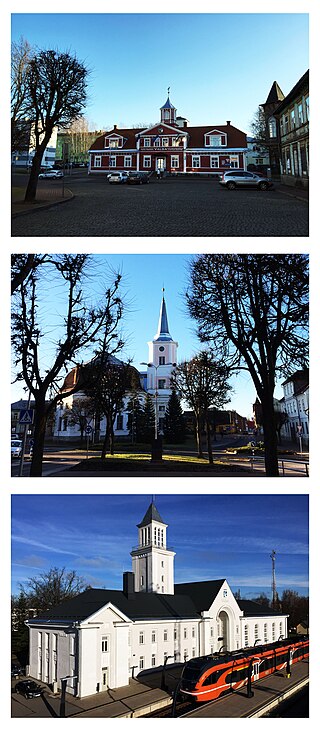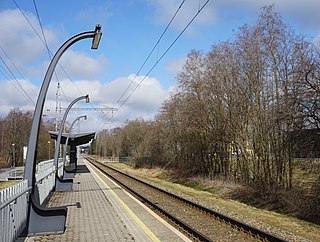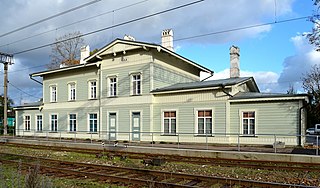
The history of rail transport in Estonia starts in 1870 when a railway line was opened connecting Paldiski, Tallinn, Tapa and Narva; the line extending all the way to Saint Petersburg in Russia. [1]

The history of rail transport in Estonia starts in 1870 when a railway line was opened connecting Paldiski, Tallinn, Tapa and Narva; the line extending all the way to Saint Petersburg in Russia. [1]

The first railway line to be built in Estonia was the Paldiski – Tallinn – Narva – Gatchina line constructed in 1870; Baltic German nobility provided the impetus for the construction of the line, though because of the Russian influence the line was built to 1524mm (5 ft) gauge [2] to connect with the line from Saint Petersburg to Warsaw . [1] The construction project was controlled by the Russian Ministry of Roads. [2] The port of Paldiski was chosen because its southerly position made it ice free all the year round. [1] Soon after both Paldiski and Tallinn experienced an upswing in trade, notably exports of grain. [1]
In 1877 another line was complete, connecting Tapa and Tartu; later extended to Valga in 1887, which brought a connection to Latvia via the Pskov – Valga – Riga line also being constructed at the same time. [1]
Additionally a network of narrow gauge railways (750mm) were being built in Estonia, the first connecting Valga and Pärnu in 1896, then Mõisaküla to Viljandi (1897), later extended via Paide to Tallinn in 1901. [1]


At the end of World War I and the collapse of the Russian Empire, the country was occupied by Germany and a puppet government installed. This subsequently collapsed with German defeat in World War I and Estonia became a republic in 1918. Finally, after the expulsion of invading Soviet forces during the Estonian War of Independence, Estonia became a recognised independent republic in 1920.
At the time of its creation, the railways had 648 km of broad gauge and 187 km of narrow gauge track and 90 broad gauge locomotives, 72 narrow gauge locomotives plus rolling stock. [3]
Thus the railways of Estonia became known as Eesti Raudtee (EVR), formed from the Looderaudtee (North-Western Railway), Esimese Juurdeveoteede Selts (First Association of Approach Tracks)[ clarification needed ] as well as military and other railway lines. [1] One consequence of the new independence was that the railway architecture did not have to follow the imperial style set out in St. Petersburg - architectural trends followed those in other parts of the world - with neo-baroque styles with romantic-vernacular elements giving way to functionalist architecture in the 1930s. [2]
In 1931, a 1524mm gauge line opened between Tartu and Petseri. [1]
By 1940, the EVR had 772 km of broad gauge and 675 km of narrow gauge track. [1] [3]
In June 1940, Estonia was invaded by the Soviet Union becoming the Estonian SSR; EVR became part of the Russian rail system again, the country was invaded by Nazi Germany and occupied by German forces between 1941 and 1944. During German occupation the network was converted to standard (1435mm) gauge, and rolling stock from Germany used. [3] After the end of the Second World War, Estonia was once again part of the Soviet Union and the railways were run as part of the Soviet Union's rail network; the track was converted back to broad gauge. [3]

Much infrastructure was destroyed during the war and as a consequence many station buildings are in the neo-classicist style (see Stalinist architecture) having been rebuilt in the post war years. [2]
Soviet planning placed the emphasis on broad gauge track and much freight formerly transported on narrow gauge lines was moved by road, lines were also converted to broad gauge. [4] Starting in 1957, steam locomotives began to be replaced by diesel locomotives. [1] Though the narrow gauge lines were closed the broad gauge sections prospered: in 1945 passenger numbers were 12.2 million, freight volumes 4.3million tonnes. [3] The railway network became part of the Pribaltiiskaya Railway [note 1] [4]
New broad gauge lines were built in the 1960s replacing some of the narrow gauge lines while some others were closed. [4] [note 2] The last public narrow gauge line closed in June 1973. [4]
In 1980, 36.5 million passengers were being carried. [3]
The construction of a new port at Muuga (north-east of Tallinn) began in 1982, as part of that project a new railway link between Tallinn and Tapa was updated to a double track to allow more rail traffic to pass through the railway line, the construction started in March 1985 and was completed in January 1992.
In 1990, 30.1 million tonnes of freight carried; the new port contributing significantly to this figure. [3]

Estonia began moving towards a second independence in 1988, and by 1991 was recognised as an independent state. On 1 January 1992 Eesti Raudtee (EVR) came into being as a state owned company. [1]
As part of a privatisation plan EVR became Estonian Railways Ltd. in 1997 with the state controlling 100% of the shares. [5]
Three organisations were formed in 1997–1998 for future privatisation: [1] [5] [6]
In 2001 a 66% stake in EVR was acquired for $58 million by Baltic Rail Services (BRS). [9] Whilst under private ownership many second hand American built GE locomotives were introduced. [3] In 2007 EVR was re-nationalised and the company became 100% state owned again. [6]
In 2004 Estonia joined the European union – for rail transport this has clear consequences, an EU directive of 1991 (EU Directive 91/440) suggested the separation of railway operation structure into track, and train operators with the intention of encouraging or allowing new railway operators to be able to run trains on other companies tracks ("de-monopolisation of railways"), [10] a related directive extends the encouragement of competition to inter-state railway operations. For the railways of Estonia this means the possibility of new companies operating on Estonian railways such as the Haapsalu Raudtee which sees restarting passenger operations on the Haapsalu line as a possible option, [11] and increased competition from other railways, such as the Russian company SeverStal. [12]

Valga is a town in southern Estonia and the capital of Valga County and Valga Parish. Until their separation in 1920, Valga and the town of Valka in northern Latvia were one town. They are now twin-towns. The area of Valga is 16.5 square kilometres and that of Valka is 14.2 km2 (5.5 sq mi). Their populations are respectively 12,261 and 6,164. On 21 December 2007 all border-crossing points were removed and roads and fences opened between the two countries with both countries joining the Schengen Agreement.

Edelaraudtee is an Estonian railway infrastructure owner and freight operator.

AS Eesti Liinirongid, operating as Elron, is a government-owned passenger train operator in Estonia.
Eesti Raudtee or EVR is the national railway infrastructure company of Estonia. It owns a network of 1,191 kilometres (740 mi) of broad gauge railway throughout the country, including the 192 kilometres (119 mi) used by the Elron commuter trains around Tallinn. Its sole shareholder is the Government of Estonia.

The rail transport system in Estonia consists of about 1,200 kilometres (750 mi) of railway lines, of which 900 kilometres (560 mi) are currently in public use. The infrastructure of the railway network is mostly owned by the state and is regulated and surveyed by the Estonian Technical Surveillance Authority.

GoRail is a rail freight operator in Estonia, and also offers related training services. Until commencing offering freight services in 2019 it was a passenger service operator, and until 2020 it operated the only direct international passenger rail services from Estonia.

Baltic Station is the main railway station in Tallinn, Estonia, and the largest railway station in Estonia. All local commuter, long-distance and international trains depart from the station.

Lilleküla railway station is a railway station in the Kristiine district of Tallinn, the capital of Estonia. The station is situated between the subdistricts Lilleküla and Uus Maailm, and close to the Estonian national football home ground A. Le Coq Arena and Kristiine Keskus, one of the biggest and most popular shopping centres in Tallinn.

The Tallinn–Tapa railway is a 77.8-kilometre (48.3 mi) long double track partly electrified railway line in Estonia, connecting the cities of Tallinn and Tapa.

The Tallinn–Narva railway is a 211 km (131 mi) long railway line in Estonia which runs through Northern Estonia between Estonia's capital city Tallinn and the city of Narva on the border with Russia.

Ülemiste railway station is a railway station in the Ülemiste sub-district of Tallinn, the capital city of Estonia. It is located approximately 500 metres from Tallinn Airport, to which it has been connected by a tramline since 2017.

Laagri railway station is a station in the Nõmme district of Tallinn, Estonia. The railway station serves the Laagri sub-district of Nõmme and Laagri borough of Saue parish which in combination has approximately 6400 residents.

Nõmme railway station is a railway station in Nõmme, Tallinn, Estonia. The station serves the Nõmme sub-district which has approximately 6600 residents.

Rahumäe railway station is a railway station serving Rahumäe, a subdistrict of the Nõmme district of Tallinn, Estonia. Rahumäe has approximately 3000 residents.

Järve railway station is a railway station in the Kristiine district of Tallinn, Estonia. The station serves the Järve sub-district which has approximately 3000 residents.

Paldiski railway station is a railway station serving the town and Baltic Sea port of Paldiski, situated on the Pakri Peninsula of northwestern Estonia.

Viljandi railway station is a railway station serving the town of Viljandi in southern Estonia.

Saue railway station is a railway station serving the town of Saue in Saue Parish in Harju County in northern Estonia.

Valingu railway station is a railway station serving the village of Saue in Saue Parish in Harju County in northern Estonia.

Keila railway station is a railway station serving the town of Keila in Harju County in northern Estonia.